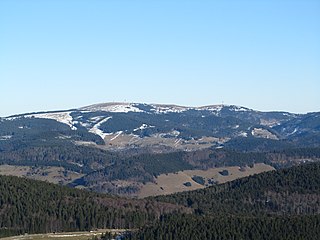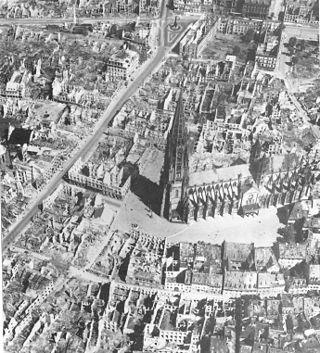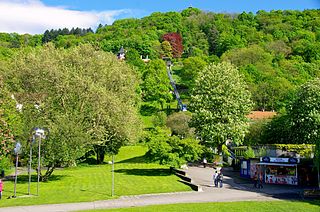Related Research Articles

Christoph Meckel was a German author and graphic artist. He received awards for his works which connect illustrations with the written text, sometimes texts by others.

Rieselfeld is a city quarter (Stadtteil) in Freiburg im Breisgau. It is located in the western part of the city and borders the nature reserve Freiburger Rieselfeld in the west, right next to a little zoo called Tiergehege Mundenhof, Opfinger Straße in the south and Besançonallee in the east. The industrial area Haid is part of the Sankt Georgen district and is located to the south of Rieselfeld, while the district Weingarten is situated to the east of Rieselfeld.

Freiburg Hauptbahnhof is the central railway station of the German city of Freiburg im Breisgau. The Rhine Valley Railway (Mannheim–Basel), Höllentalbahn and the Breisach Railway (Breisach–Freiburg) meet here.

At a height of 1,448.2 m above sea level (NHN), the Seebuck is the second highest mountain of the Black Forest after the Feldberg. It is located in the German state of Baden-Württemberg.

Operation Tigerfish was the military code name in World War II for the air raid on Freiburg in the evening of 27 November 1944 by the Royal Air Force with about 2,800 dead.
The German city of Freiburg was bombed erroneously on 10 May 1940 by the Luftwaffe, killing 57 inhabitants.

The Kaiser-Joseph-Straße in Freiburg im Breisgau is a shopping street of about 900 meters, which runs through the center of Freiburg's historic downtown from north to south. It is one of the most expensive locations in Germany.

The Bertoldsbrunnen is a monument in the historic city of Freiburg im Breisgau. It is situated at the crossing of the Salz- and Bertoldsstraße with the Kaiser-Joseph-Straße. The fountain is one of the central locations of the city. A tram station with the same name is situated at the Bertoldsbrunnen where four of the five tramways of the Freiburger Verkehrs AG stop.

The Siegesdenkmal in Freiburg im Breisgau is a monument to the German victory in the Franco-Prussian War in 1871. It was erected at the northern edge of the historic center of Freiburg im Breisgau next to the former Karlskaserne (barracks). After World War II it was moved 100m to the west. Today it is located on Europaplatz.

The Whale House is a late Gothic bourgeois house in the old town of Freiburg im Breisgau, Baden-Württemberg, Germany and is under conservation. The building is currently used by the Sparkasse Freiburg-Nördlicher Breisgau bank. It is part of a complex which, in the past, was made up of 17 separate buildings. The front wall of the house opens onto the Franziskanerstraße, whilst the rear is on the Gauchstraße, near Kartoffelmarkt square.
Georg Schreyögg was a German sculptor. One of his better known surviving works is the 1907 St Barbara War Memorial in Koblenz, taken down to make way for a new road in 1956 but returned to a site in the city close to its original location in 2014.

Karl Friedrich Moest was a German sculptor.

The Colombischlössle is a manor house in the city centre of Freiburg im Breisgau where the eponymous archaeological museum is situated.

The Stadtgarten of Freiburg is a 2.6 ha park within the Neuburg district. It has an old tree grove and a large rose garden, and lies between the Leopoldring, Jackob Burckhardt, Ludwig and Mozart streets near Freiburg's city centre. It is connected to Karlsplatz via the Karlssteg footbridge, which is made from pre-stressed concrete. Since 2008 the Schlossberg Tram, an inclined elevator, leads up to Schlossberg. It replaced the Schlossberg Cable Car built in 1968.

The Platz der Alten Synagoge is a square in Freiburg, Germany. With a size of 130 by 130 metres, it is the second largest square in the city after Minster Square. The square is named after the old synagogue, which was destroyed during the Kristallnacht in 1938. The synagogue had been built in 1869/1870 to the southwest of today's location of the square.
Hans Baur was a German sculptor.

The Bismarck tower in Freiburg im Breisgau belongs to a series of towers that were built in honor of Otto von Bismarck, the first German chancellor. It is located on the Schlossberg. It is 12.6 m (41 ft) tall and has a square base. The top of the tower can only be reached by climbing a ladder. Because of this it can not be used as an observation deck.
Berta Ottenstein was a German dermatologist who was the first woman to obtain her habilitation at the University of Freiburg im Breisgau and the first woman in Germany to habilitate in dermatology.
Waltraud Isoldé Elchlepp is a German protest song singer under the pseudonym Dominique, and an operatic mezzo-soprano and soprano who appeared at major German opera houses and festivals including the Bayreuth Festival. She took part in world premieres such as Reimann's Das Schloß and Bernarda Albas Haus at the Bavarian State Opera. Besides the standard repertoire, she appeared in roles such as Othmar Schoeck's Penthesilea at the Staatsoper Hannover.
Siegfried Schmalzriedt was a German musicologist, University lecturer and vice-rector of the Hochschule für Musik Karlsruhe.
References
- 1 2 3 Brigitte Baumstark. "Blick in die Geschichte Nr. 97 vom 14. Dezember 2012: Biographie Fridolin Dietsche". Karlsruhe: Stadtgeschichte. Stadt Karlsruhe. Retrieved 29 November 2016.
- 1 2 Anett Beckmann (2006). Mentalitätsgeschichtliche und ästhetische Untersuchungen der Grabmalsplastik des Karlsruher Hauptfriedhofes. KIT Scientific Publishing. p. 169. ISBN 978-3-86644-032-6.
- ↑ Ute Scherb: Wir bekommen die Denkmäler, die wir verdienen. Freiburger Monumente im 19. und 20. Jahrhundert. (= Veröffentlichungen aus dem Archiv der Stadt Freiburg im Breisgau. Vol. 36). Freiburg 2005, ISBN 3-923272-31-6, p. 88f.
- ↑ Karl Schmid, Hans Schadek: Die Zähringer. Vol. 2: Anstoss und Wirkung. Thorbecke, Sigmaringen 1986, ISBN 3-7995-7041-1, p. 368 f.
- ↑ Ute Scherb: Wir bekommen die Denkmäler die wir verdienen. Freiburger Monumente im 19. und 20. Jahrhundert. from: Ulrich P. Ecker, Christiane Pfanz-Sponagel, Hans-Peter Widmann (compiler-editor): Veröffentlichungen aus dem Archiv der Stadt Freiburg im Breisgau., 2005, p. 89.
- ↑ Diverse. In: Heinz Schmitt (Hrsg.): Denkmäler, Brunnen und Freiplastiken in Karlsruhe 1715–1945. 2nd edition Vol. 7, Karlsruhe 1989, ISBN 3-7617-0264-7, p. 420 (Published by the Karlsruhe city archive).
- ↑ Albert Herzog (2008). Ihr glücklichen Augen: ein Karlsruher Journalist erzählt aus seinem Leben. Literarische Gesellschaft. p. 167. ISBN 978-3-88190-500-8.